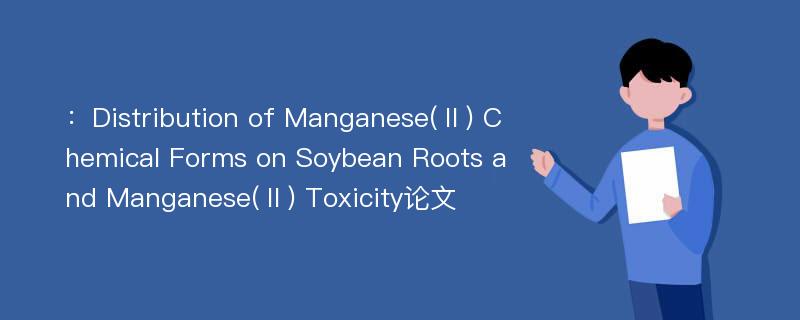
本文主要研究内容
作者(2019)在《Distribution of Manganese(Ⅱ) Chemical Forms on Soybean Roots and Manganese(Ⅱ) Toxicity》一文中研究指出:Distribution of chemical forms of manganese(Ⅱ)(Mn(Ⅱ))on plant roots may affect Mn(Ⅱ)absorption by plants and toxicity of Mn(Ⅱ)to plants at its high level.The chemical forms of Mn(Ⅱ)on soybean roots were investigated to determine the main factors that affect their distribution and relationship with Mn(Ⅱ)plant toxicity.Fresh soybean roots were reacted with Mn(Ⅱ)in solutions,and Mn(Ⅱ)adsorbed on the roots was differentiated into exchangeable,complexed,and precipitated forms through sequential extraction with KNO3,EDTA,and HCl.The exchangeable Mn(Ⅱ)content on the roots was the highest,followed by the complexed and precipitated Mn(Ⅱ)contents.Mn(Ⅱ)toxicity to the roots was greater at pH 5.5 than at pH 4.2 due to the larger amount of exchangeable Mn(Ⅱ)at higher pH.The cations Al3+,La3+,Ca2+,Mg2+,and NH4+competed with Mn(Ⅱ)for cation exchange sites on the root surfaces and thus reduced exchangeable Mn(Ⅱ)on the roots,in the order Al3+,La3+>Ca2+,Mg2+>NH4+.Al3+ and La3+ at 100μmol L-1 decreased exchangeable Mn(Ⅱ)by 80%and 79%,respectively,and Ca2+ and Mg2+at 1 mmol L-1 decreased exchangeable Mn(Ⅱ)by 51%and 73%,respectively.Organic anions oxalate,citrate,and malate reduced free Mn(Ⅱ)concentration in solution through formation of complexes with Mn(Ⅱ),efficiently decreasing exchangeable Mn(Ⅱ)on the roots;the decreases in exchangeable Mn(Ⅱ)on the roots were 30.9%,19.7%,and 10.9%,respectively,which was consistent with the complexing ability of these organic anions with Mn(Ⅱ).Thus,exchangeable Mn(Ⅱ)was the dominant form of Mn(Ⅱ)on the roots and responsible for Mn(Ⅱ)toxicity to plants.The coexisting cations and organic anions reduced the exchangeable Mn(Ⅱ)content,and thus they could alleviate Mn(Ⅱ)toxicity to plants on acid soils.
Abstract
Distribution of chemical forms of manganese(Ⅱ)(Mn(Ⅱ))on plant roots may affect Mn(Ⅱ)absorption by plants and toxicity of Mn(Ⅱ)to plants at its high level.The chemical forms of Mn(Ⅱ)on soybean roots were investigated to determine the main factors that affect their distribution and relationship with Mn(Ⅱ)plant toxicity.Fresh soybean roots were reacted with Mn(Ⅱ)in solutions,and Mn(Ⅱ)adsorbed on the roots was differentiated into exchangeable,complexed,and precipitated forms through sequential extraction with KNO3,EDTA,and HCl.The exchangeable Mn(Ⅱ)content on the roots was the highest,followed by the complexed and precipitated Mn(Ⅱ)contents.Mn(Ⅱ)toxicity to the roots was greater at pH 5.5 than at pH 4.2 due to the larger amount of exchangeable Mn(Ⅱ)at higher pH.The cations Al3+,La3+,Ca2+,Mg2+,and NH4+competed with Mn(Ⅱ)for cation exchange sites on the root surfaces and thus reduced exchangeable Mn(Ⅱ)on the roots,in the order Al3+,La3+>Ca2+,Mg2+>NH4+.Al3+ and La3+ at 100μmol L-1 decreased exchangeable Mn(Ⅱ)by 80%and 79%,respectively,and Ca2+ and Mg2+at 1 mmol L-1 decreased exchangeable Mn(Ⅱ)by 51%and 73%,respectively.Organic anions oxalate,citrate,and malate reduced free Mn(Ⅱ)concentration in solution through formation of complexes with Mn(Ⅱ),efficiently decreasing exchangeable Mn(Ⅱ)on the roots;the decreases in exchangeable Mn(Ⅱ)on the roots were 30.9%,19.7%,and 10.9%,respectively,which was consistent with the complexing ability of these organic anions with Mn(Ⅱ).Thus,exchangeable Mn(Ⅱ)was the dominant form of Mn(Ⅱ)on the roots and responsible for Mn(Ⅱ)toxicity to plants.The coexisting cations and organic anions reduced the exchangeable Mn(Ⅱ)content,and thus they could alleviate Mn(Ⅱ)toxicity to plants on acid soils.
论文参考文献
论文详细介绍
论文作者分别是来自Pedosphere的,发表于刊物Pedosphere2019年05期论文,是一篇关于,Pedosphere2019年05期论文的文章。本文可供学术参考使用,各位学者可以免费参考阅读下载,文章观点不代表本站观点,资料来自Pedosphere2019年05期论文网站,若本站收录的文献无意侵犯了您的著作版权,请联系我们删除。
